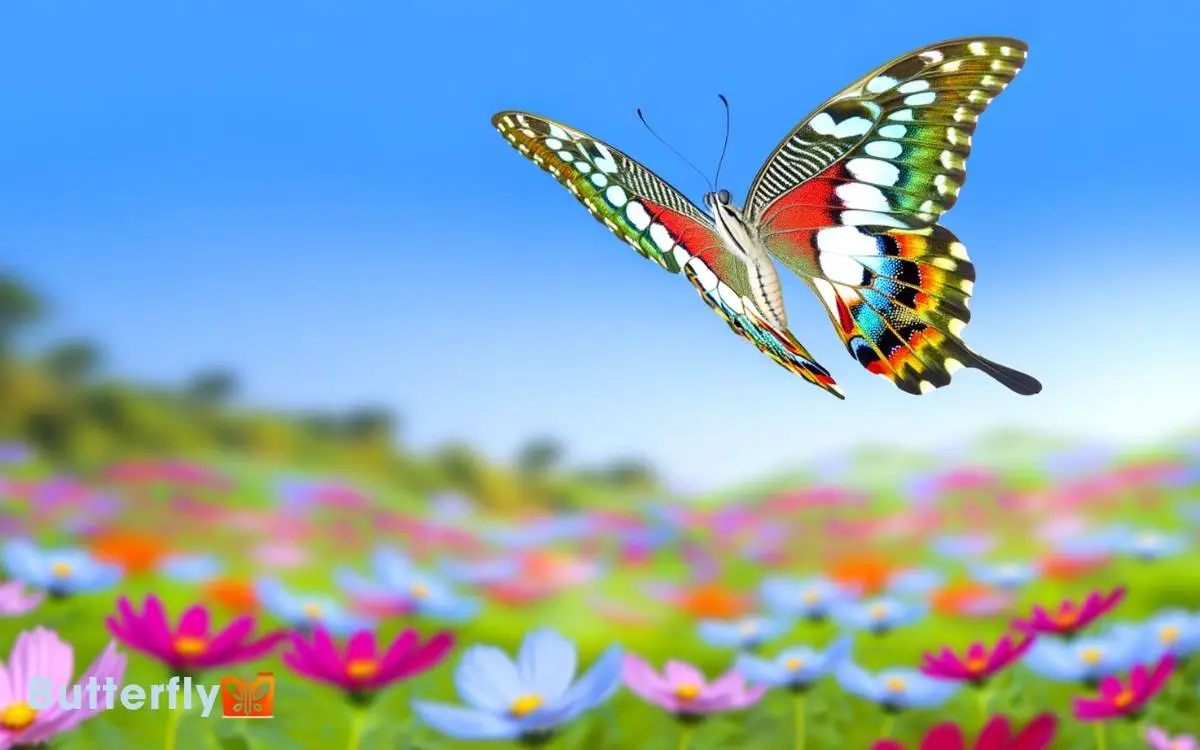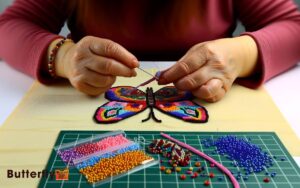How To Draw A Butterfly In Flight? Step-by-Step Guide!
To draw a butterfly in flight, gather your sketchbook, pencils, erasers, and colored pencils or markers.
Start by lightly sketching an elongated oval for the body with a slight curve to imply motion. Add a small circle for the head and thin, curved lines for the antennae. Draw large, curved upper wings and slightly smaller lower wings, ensuring symmetry.
Add intricate patterns and veins on the wings. Illustrate flight dynamics by capturing different wing positions. Refine your lines, add color, and highlight details for realism. Follow these detailed steps and soon your butterfly will appear ready to take off.

Key Takeaways
Gather Your Materials
First, gather your materials: a sketchbook, pencils, erasers, colored pencils or markers, and a reference image of a butterfly in flight.
Start by selecting a high-quality sketchbook that can handle both pencil and color. Choose a variety of pencils, from hard (H) to soft (B), for diverse line qualities.
Don’t forget a good eraser for corrections and adjustments. Colored pencils or markers will add vibrancy to your butterfly.
Finally, find a reference image that captures the dynamic beauty of a butterfly in motion. This will serve as your visual guide and inspiration.
By preparing these tools, you’ll set yourself up for a creative and successful drawing session. Now, you’re ready to bring your butterfly to life!
Sketch the Body
With your reference image at hand, lightly sketch the elongated oval shape for the butterfly’s body. Position it centrally on your paper to allow space for the wings later. Make sure the oval is narrow and tapers slightly at both ends, mimicking the body’s natural shape.
Next, add a gentle curve to give the impression of a dynamic, flying motion. This will make your butterfly look more lifelike and in action.
Add two small circles at the top for the head. Draw two thin, curved lines extending from the head for the antennae. Keep your lines light and adjustable.
Draw the Wings
Now, sketch the upper wings by drawing two large, curved shapes extending from either side of the butterfly’s body. Make sure these wings are essential to create a balanced look.
Next, focus on the lower wings. These should be slightly smaller and more rounded. Again, symmetry is vital here.
To help visualize:
- Upper Wings: Large, curved shapes extending outward.
- Lower Wings: Smaller, rounded shapes below the upper wings.
- Symmetry: Make sure both sides mirror each other.
- Connection: Wings should seamlessly emerge from the body.
Keep your lines light and smooth; you can refine them later. Remember, innovation comes from practice and patience. You’re doing an excellent job!
The butterfly’s wings are vital to capturing its elegance in flight.
Add Wing Details
To bring your butterfly to life, start by adding intricate patterns and veins on the wings. Use a fine-tipped pen or pencil to sketch delicate lines radiating from the base of the wings outward.
These lines should mimic the natural vein structure. Next, create symmetrical patterns such as dots, stripes, or eye spots to add visual interest.
Here’s a quick reference to guide your detailing:
| Pattern Type | Description |
|---|---|
| Veins | Thin lines radiating from wing base |
| Eye Spots | Circular patterns with contrasting colors |
| Stripes | Horizontal or vertical lines adding dimension |
| Dots | Small, evenly spaced circles |
| Borders | Thickened lines outlining the wings |
Be innovative and let your creativity shine through, ensuring each wing reflects the butterfly’s natural beauty.
Illustrate Flight Motion
To illustrate flight motion, start by sketching the wing position dynamics during different phases of the butterfly’s wingbeat. Pay close attention to how the wings move up and down, creating a rhythmic pattern.
Next, capture the body movement patterns, showing the gentle sways and shifts as the butterfly navigates through the air.
Wing Position Dynamics
Start by sketching the butterfly’s wings in various positions to capture the natural fluidity of its flight.
Focus on the following key wing positions to illustrate dynamic motion:
- Upward Stroke: Draw the wings at the peak of their upward movement, slightly curved, showing the lift.
- Mid-Flap: Sketch the wings halfway through their flap, angled to show motion and energy.
- Downward Stroke: Illustrate the wings fully extended downward, indicating the push against the air.
- Resting Position: Capture the wings close together, as they momentarily pause in the cycle.
Body Movement Patterns
Frequently, you should observe how the butterfly’s body subtly shifts in coordination with its wing movements to accurately depict the rhythm and grace of its flight.
- Start by sketching a gentle curve for the body, mimicking the natural undulation during flight.
- As the wings flap, the body slightly lifts and dips capture this with small, incremental lines.
- To show upward motion, angle the body slightly upward; for downward motion, angle it slightly downward.
- Don’t forget to add slight twists to the body as it turns mid-air.
- This attention to detail will give your drawing a dynamic, lifelike quality.
Practice these movements repeatedly, and soon, you’ll master illustrating the fluid, elegant motion of a butterfly in flight.
Refine the Lines
Once you’ve sketched the basic outline, carefully trace over your lines to enhance the butterfly’s delicate wings and intricate patterns. Focus on creating smooth, clean lines that bring your butterfly to life.
Follow these steps:
- Wings: Emphasize the curves and angles of the wings, ensuring symmetry and elegance.
- Veins: Add fine lines to represent the veins on the wings, creating a realistic texture.
- Body: Boldly outline the body, highlighting the segments and adding antennae.
- Patterns: Trace distinctive markings and spots, ensuring they mirror each other on both wings.
Add Color and Shading
Now, choose vibrant colors to bring your butterfly to life. Apply light shading to create depth and dimension, making your butterfly appear more realistic.
Choose Vibrant Colors
Choose a palette of vibrant colors to bring your butterfly to life, focusing on bold hues that will make its wings pop against the background.
Start by selecting a primary color for the wing base and then add contrasting shades for intricate patterns.
Follow these steps to create an eye-catching butterfly:
- Base Color: Choose a vivid color like electric blue or fiery orange as the base.
- Contrasting Patterns: Add bold patterns using colors like deep purple or bright yellow.
- Accent Highlights: Use metallic or neon shades to highlight specific areas.
- Balance: Make sure your color choices balance, making the butterfly visually stunning.
Experiment with these colors, and don’t hesitate to blend shades to create a unique, innovative design.
Apply Light Shading
To enhance the realism of your butterfly, start applying light shading to create depth and dimension on its wings.
Begin by identifying the areas that would naturally fall into shadow, such as the edges and near the body. Use a soft pencil or light-colored marker to gently shade these regions, ensuring smooth shifts between light and dark.
Next, blend the shading with a blending tool or your finger, softening any abrupt lines. This technique adds a nuanced, lifelike texture to the wings.
Don’t forget to shade the undersides of the wings slightly darker than the tops, reflecting how light hits them differently. Experiment with varying pressure to achieve a dynamic, three-dimensional effect that makes your butterfly appear as if it’s truly in flight.
Enhance Wing Details
Building on the light shading, start adding vibrant colors to the wings to bring your butterfly to life. Use a variety of hues to create a dynamic and eye-catching effect.
Follow these steps:
- Choose Your Palette: Select bright and contrasting colors to make the wings pop.
- Apply Base Colors: Lay down the primary colors on each wing section, ensuring smooth, even coverage.
- Add Gradient Effects: Blend colors where they meet to create a natural, smooth shift.
- Detail with Accents: Use a fine-tipped brush or pencil to add intricate patterns and highlights.
Experiment with different color combinations and techniques to make your butterfly unique. Don’t be afraid to innovate and push your creative boundaries! You can draw inspiration from nature, incorporating patterns and textures that mimic the unique traits of the sea butterfly, such as its delicate, translucent wings. Blending unexpected hues or using mixed media can add depth and dimension to your artwork. Let your imagination guide you as you create a butterfly that truly stands out.
Final Touches and Highlights
With your butterfly nearly complete, now’s the perfect time to add the final touches and highlights to make it truly come to life. Start by refining the edges with a fine-tipped pen or pencil. This sharpens the lines and adds definition.
Next, use a white gel pen to add tiny highlights on the wings, mimicking the way light catches on them. Don’t forget the body; a few well-placed highlights can add depth and realism.
Finally, consider adding a subtle shadow beneath the butterfly to give the illusion of flight. This small detail can make a big difference in creating a dynamic, lifelike image.
You’ve now transformed your drawing into a masterpiece ready to take flight!
Conclusion
You’ve done it! Your butterfly now looks as if it’s ready to flutter off the page. With its vibrant wings spread wide and delicate details meticulously drawn, you can almost feel the breeze from its flight.
The dynamic motion lines give it life, and the added color and shading bring depth and realism. Just a few final touches, and your artwork will truly soar.
Keep practicing, and soon, you’ll be creating entire gardens of fluttering butterflies!






